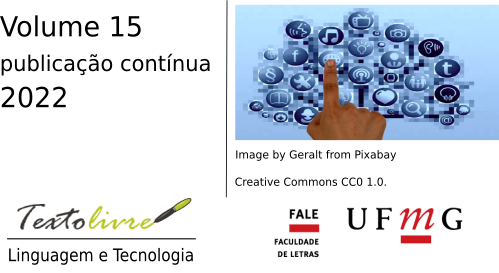Neuropedagogy and neuroimaging
DOI:
https://doi.org/10.35699/1983-3652.2022.40453Palabras clave:
Neuropedagogy, Neuroimaging, Pedagogy, Teaching, BrainResumen
The present study is based on the assumption that there is a lack of information, both nationally and internationally, on neuropedagogy, and that there is more than enough evidence of the need for a conceptualization of neuropedagogy. Therefore, the general objective is to analyze the relationship between neuroeducation, neurodidactics, teacher training and neuropedagogy. Data collection was carried out with a 27-item ad hoc Likert scale questionnaire, reliable (Cronbach's Alpha, .973), and validated in its content and construct with an exploratory factor analysis (KMO (.843), Bartlett (Sign.000), Determinant (9.416E-19)). The research sample was selected by convenience from among university teachers in Spain, Paraguay, Ecuador, Brazil and Mexico, with a total of 1264 participants. The research design is non-experimental, descriptive, explanatory, correlational and regression-based. The results show that the future of pedagogy must include neuropedagogy, evidencing: 1) the need of neuroeducation knowledge for Neuropedagogy; 2) the understanding of neurodidactics as the practical application for neuropedagogy, 3) the importance of neuro-orientation and neuro-educational organization, and 4) the need for the training of trainers. All of which is reinforced by the examples shown of neuroimaging that demonstrate the need for neuropedagogy and teacher training in neuropedagogy.
Descargas
Referencias
BÉJAR, M. Neuroeducación. Padres y Maestros / Journal of Parents and Teachers, n. 355, p. 49–53, 2014. Available from: https://revistas.comillas.edu/index.php/padresymaestros/article/view/2622. Visited on: 22 Aug. 2022.
BLAKEMORE, S. J.; FRITH, U.; CHIC, J. S. Cómo aprende el cerebro: Las claves para la educación. Prólogo de José Antonio Marina. Barcelona: Editorial Ariel, Jan. 2007.
CÁRDENAS GÓMEZ, W. G. Identificación y monitoreo de señales cerebrales que intervienen en movimientos involuntarios de articulaciones en pacientes con Parkinson. Emotiv Epoc X. 2021. Maestria en Ciencias en Ingeniería Electrica – Tecnológico Nacional de México, Torreón, Coahuila. México. Available from: https://rinacional.tecnm.mx/bitstream/TecNM/1664/1/%2801%29-TMCIE-2021-Williams%20Gerardo%20C%C3%A1rdenas%20G%C3%B3mez.pdf. Visited on: 22 Aug. 2022.
CARDINALI, D. Neurociencia aplicada: sus fundamentos. México: Médica Panamericana, 2007.
CASTILLO, C. Neurociencias y su relación en el proceso enseñanza aprendizaje. 2015. Maestría en psicopedagogía y orientación tutorial – Universidad Católica Sedes Sapientiae, Lima, available from: https://repositorio.ucss.edu.pe/bitstream/handle/20.500.14095/180/Castillo_Galdo_tesis_maestria_2015.pdf?sequence=5&isAllowed=y. Visited on: 22 Aug. 2022.
CUMPA VALENCIA, M. Usos y abusos del término “neurociencias”: una revisión sistemática en revistas indexadas en Scielo. Revista ConCiencia EPG, v. 4, 1 (Enero - junio), p. 30–67, 2019. DOI: https://doi.org/10.32654/CONCIENCIAEPG.4-1.3. Available from: https://dialnet.unirioja.es/servlet/articulo?codigo=7304977. Visited on: 22 Aug. 2022.
DURKHEIM, E. Jugements de valeur et jugements de réalité. Revue de Métaphysiue et de Morale, v. 19, p. 437–453, 1911.
GARCÍA FERRANDO, M. et al. El análisis de la realidad social: métodos y técnicas de investigación. Madrid: Alianza editorial, 2015.
GEORGE, D.; MALLERY, P. SPSS for Windows step by step: A simple guide and reference. Boston: Allyn & Bacon, 2003.
HERBERT, F. Dune. Barcelona: Ediciones Nova, 1965.
HERNÁNDEZ, A.; DE BARROS, C. Neuroimagen en Neuropedagogía. en prensa. [S.l.: s.n.], 2022.
JIMÉNEZ, C. A. Lúdica Colombia. [S.l.: s.n.], 2010. Available from: http://www.ludicacolombia.com. Visited on: 9 Mar. 2022.
KAISER, H. F. An index of factorial simplicity. Psychometrika, v. 39, n. 1, p. 31–36, Mar. 1974. DOI: 10.1007/BF02291575. Available from: https://doi.org/10.1007/BF02291575. Visited on: 22 Aug. 2022.
MANES, F.; NIRO, M. Usar el cerebro: Conocer nuestra mente para vivir mejor. Buenos Aires: Planeta, 2014.
ROTGER AMENGUAL, B. Ciencias de la educación : temas fundamentales. Madrid: Escuela Española, 1984.
SARRAMONA, J.; FERRÁNDEZ, A. Aspectos diferenciales de la educación. Barcelona: CEAC, 1977.
TORRES RÍOS, H.; ALVARADO ZERMEÑO, G.; BERNAL TRIGUEROS, A. Caracterización del neuroaprendizaje en estudiantes de licenciatura. In: DEBATES en Evaluación y Currículum. [S.l.: s.n.], 2018. v. 4. Available from: https://postgradoeducacionuatx.org/pdf2018/A231.pdf. Visited on: 22 Aug. 2022.
Descargas
Publicado
Número
Sección
Licencia
Derechos de autor 2022 Antonio Hernández Fernández

Esta obra está bajo una licencia internacional Creative Commons Atribución 4.0.
Este es un artículo de acceso abierto que permite su uso, distribución y reproducción sin restricciones en cualquier medio siempre que se cite correctamente el artículo original.











